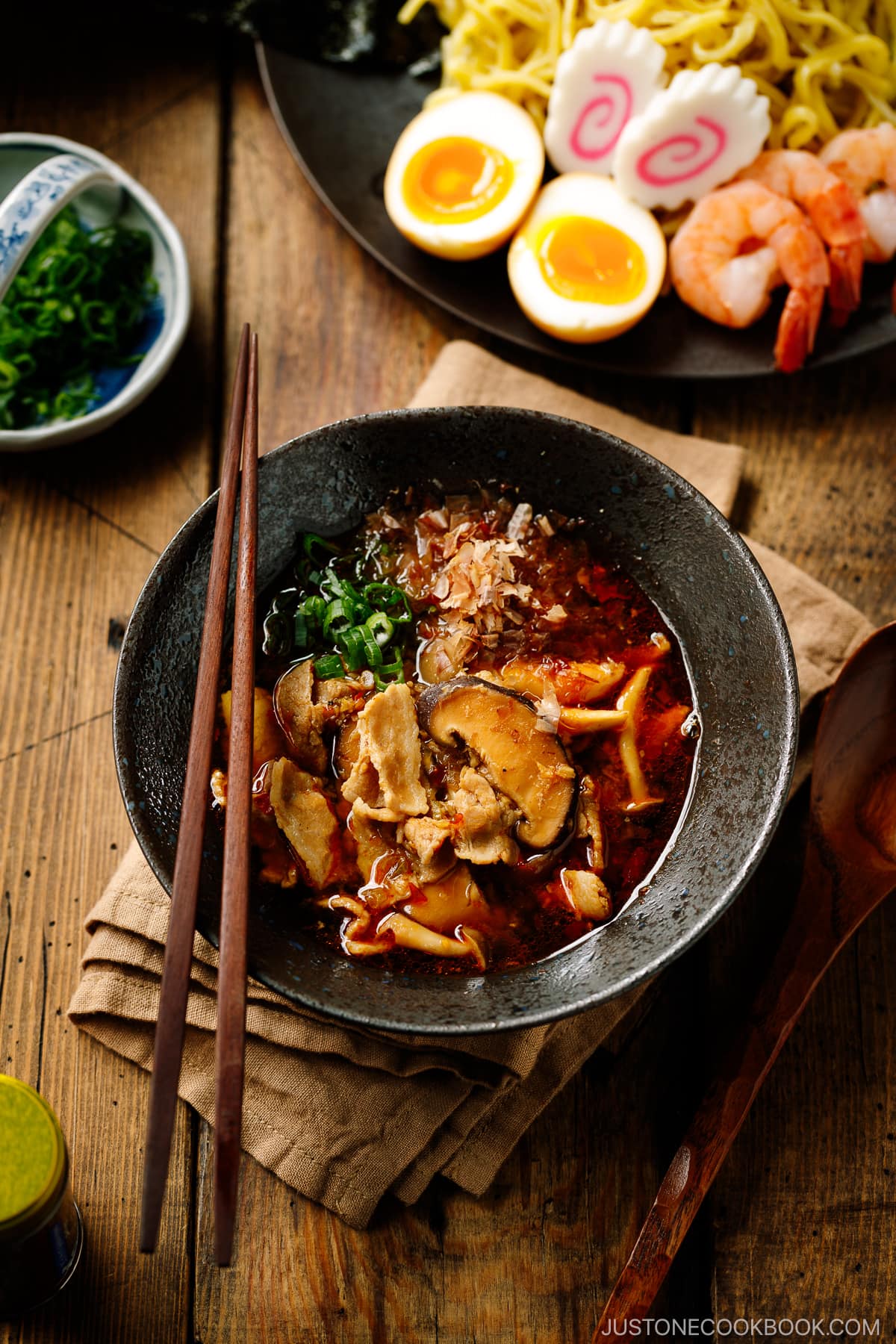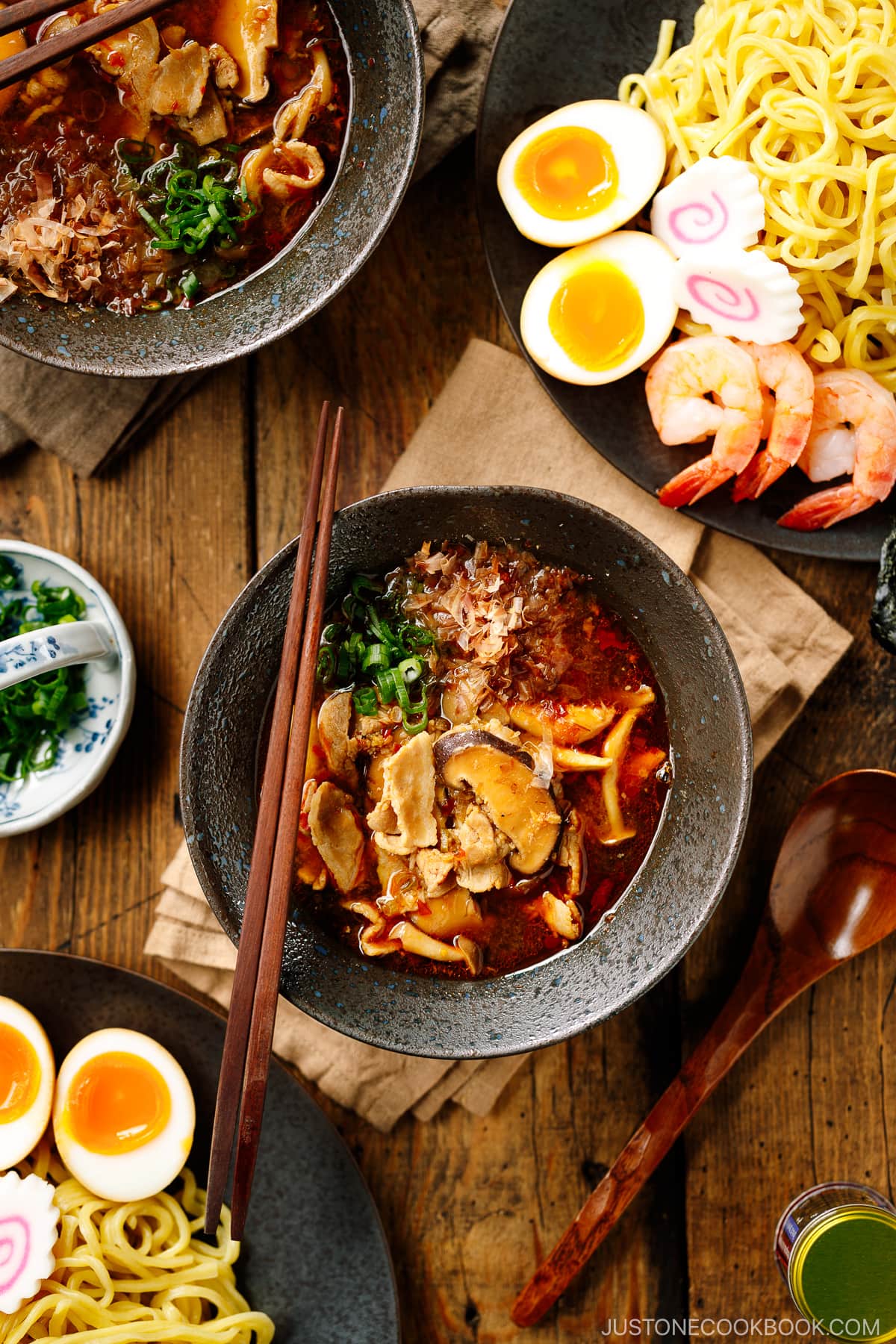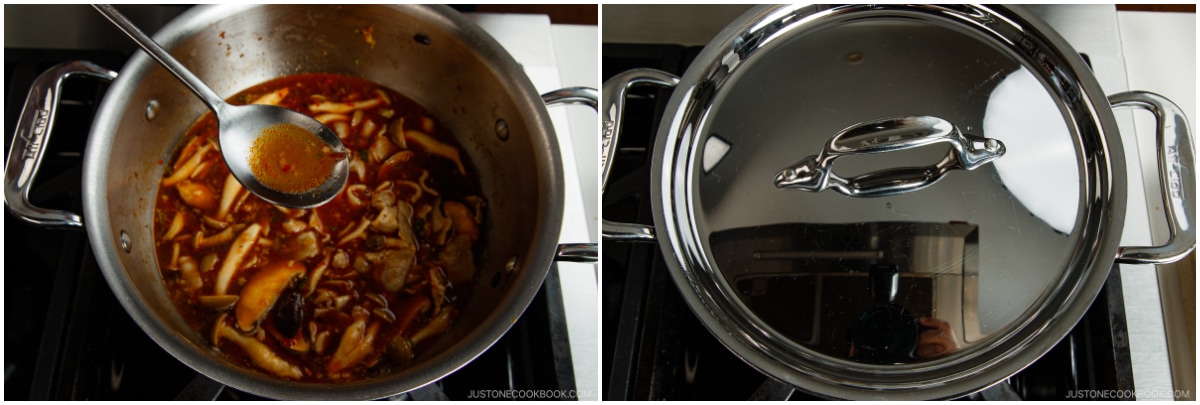Cold springy noodles dipped into a bowl of intensely flavorful hot soup, Tsukemen or Dipping Ramen Noodles is a Japanese summertime staple. The simple yet colorful toppings complete the bowl. You’ll enjoy this unique ramen dish for in-between weather days too.

Have you heard of Japanese Dipping Ramen Noodles? Known as tsukemen (つけ麺), it is one of the most beloved styles of ramen in Japan, especially during the summer months. But, it’s also delightful in transitional seasons like spring and fall, when we have days with warm sun and breezy wind.
The dish involves serving cold noodles alongside a bowl of hot soup. You would dip the noodles into the soup and enjoy the toppings served atop or on the side of the noodles. The contrast of cold noodles and hot broth, in my opinion, is literally the best of both worlds.
When the noodle craving hits, this sensational ramen is going to satisfy. So let’s make it at home today!
Table of Contents

What is Tsukemen?
Tsukemen (つけ麺)—literally dipping noodles—is a type of ramen dishes in Japanese cuisine. The most distinctive difference between tsukemen and standard ramen is the noodles and soup broth are served separately for tsukemen.
You would dip the noodles, which are typically chilled or at room temperature, into the hot savory soup broth before eating.
Other Japanese dipping noodles include Zaru Soba using buckwheat noodles or Cold Somen Noodles using super thin wheat noodles.

A Brief History of Tsukemen
There are a few theories about the origin of tsukemen, but it is said that Masayasu Sakaguchi and Kazuo Yamagishi from the ramen shop Taishoken (大勝軒) in Tokyo invented tsukemen in the late 50s.
On sweltering summer days, the staff would eat cold leftover noodles by dipping it into a hot soup flavored with soy sauce, just like how they would with Zaru Soba. The staff seemed to enjoy their meal so much that curious customers began to request to try out the dish. Eventually, they decided to put the dish on the menu.
Soon the word got out and tsukemen’s popularity started to spread across Japan during the 1970s and 80s, and it received all the rage during the ramen resurgence in the past two decades. You can now find specialty shops throughout Japan serving a variety of tsukemen dishes.
And of course, the tsukemen ramen craze finally hit the shores of the US. In 2019, Taishoken opened its first location in San Mateo, California, serving up its famous bowls of tsukemen.
Tsukemen Ramen Noodles

For tsukemen, the noodles matter more than the soup. Since you’re tasting more of the noodles, a good bowl of tsukemen is judged by the quality and texture of the noodles, just like zaru soba.
Many tsukemen shops offer housemade noodles that are thicker, chewier, and springy as the textures provide wider surface areas to absorb the sauce.
You can get Sun Noodle brand Temomi Kaedama #18 Thick Noodles (see above) from Japanese grocery stores or Myojo brand Thick Wavy Ramen Noodles.
After boiling the noodles, they are dunked in cold water to cool them down immediately. This method is known as ‘shimeru,’ which means tightening, and it helps to bring back the noodles’ springiness. Since the noodles are separately served from the broth, they stay chewy without losing their firmness.
The Dipping Soup Broth

I use fatty pork belly to create a rich broth, but you can substitute it with ground pork/chicken broth, or seafood. I also like to jazz up the broth with doubanjiang (chili bean paste) for a deep bold, spicy flavor, but feel free to adjust. Use the Taiwanese brand non-spicy doubanjiang if you have children. Read more about it in this pantry post.
You might be tempted to drink the delicious soup broth, but it is intentionally made to be on the salty side. The intensity balances off the plain ramen noodles when they soak up lots of flavors.
The tsukemen shops typically offer delicious dashi broth at the end of the meal. Add the dashi broth to your leftover dipping soup broth and enjoy the savory soup. This is called soup wari (スープ割り). The dashi is typically a blend of dried anchovy stock and katsuobushi stock. This is a fun and unique feature that tsukemen offers.
The Toppings

The toppings are usually served on top of the chilled ramen noodles on a plate. I prepare Ramen Eggs (ajitsuke tamago or ajitama) ahead of time but keep the toppings simple to make it a quick meal.
For this recipe, I cooked the peeled and deveined shrimp in boiling water until just cooked. By adding sake to the water, the alcohol helps remove the unwanted seafood smell.
The pink-swirl fish cake called narutomaki is a standard fish cake for ramen. You can skip it or use other types of fish cake.

Ingredients for Tsukemen
- Thick ramen noodles — I recommend using Sun Noodle brand Kaedama No. 18 Thick Noodles. You should be able to find it in the refrigerator section at Japanese grocery stores. You can also use Myojo brand’s Thick Wavy Ramen Noodles.
- Shimeji mushrooms and shiitake mushrooms — They can be found in Asian grocery stores. You can also use other types of mushrooms.
- Sliced pork belly — You can buy from Japanese, Korean, Chinese, and Mexican grocery stores.
- Aromatics — Ginger, garlic, green onions
- Seasoning — Toasted sesame oil, Doubanjiang (chili bean paste) (check out Taiwanese brand for the non-spicy one), soy sauce, miso, Mentsuyu (concentrated noodle soup base; or make my homemade mentsuyu), rice vinegar, black pepper, and salt
Substitutions and Variations
- Mushrooms — I used two types of mushrooms for textures and flavors, but you could use just one type.
- Sliced pork belly — You can use ground pork instead of pork belly if that’s what you have or prefer. You can use other types of meat, but pork is standard for tsukemen’s soup broth.
- Doubanjiang — This chili bean paste packs a punch of flavor and it’s worth getting a jar as your pantry staple. To learn more about this condiment and find out where to buy it, click here.
- Mentsuyu (concentrated noodle soup base) — This is a game changer if you want to make soba noodles, udon noodles, pasta, and all kinds of Japanese dishes in a fraction of time. I usually stock up one or two bottles for emergency cooking. (Type “mentsuyu” on the search bar. See? A lot of recipes come up!)
- Rice vinegar — You can use other types of vinegar; however, rice vinegar is the mildest type, so if you are going to substitute it, use less.

How to Make the Best Tsukemen at Home
- Make the dipping soup broth by stir-frying all the ingredients and adding the condiments.
- Cook the ramen noodles, run cold water, drain, and serve on individual plates.
- Place the ramen toppings on the noodles.
- Serve the dipping soup broth in individual bowls. Enjoy!
Tsukemen Cooking Tips
- Prepare the toppings ahead of time. I keep the toppings minimal and essential so that you can make this tsukemen recipe in 40 minutes from start to finish. All you need to do is to make the soup broth (fast!) and cook the ramen noodles. It’s a very doable weeknight meal!
- Add the aromatics (ginger and garlic) when the oil is not too hot. This way, you can take time to extract the flavor and fragrance and reduce the risk of burning them.
- Check the taste of the soup broth. Every brand of condiment is slightly different so don’t follow the specified amount blindly. Always check the taste of your final dish and adjust at the end. If it needs a bit of a kick, add salt. If it’s too salty, add a little water to dilute.

How to Eat Tsukemen
To enjoy this summer-perfect ramen, pick up a few strands of the noodles with your chopsticks, dip them into the soup broth, and make sure they are fully submerged, then slurp! Enjoy the various toppings by dipping them in the soup broth.
More Cold Summer Noodles You’ll Love
- Zaru Soba (Cold Soba Noodles)
- Hiyashi Chuka with Sesame Miso Sauce
- Honey Sesame Shirataki Noodles
- Oroshi Soba
- Cold Somen Noodles
- Cold Tanuki Udon

Wish to learn more about Japanese cooking? Sign up for our free newsletter to receive cooking tips & recipe updates! And stay in touch with me on Facebook, Pinterest, YouTube, and Instagram.

Tsukemen (Dipping Ramen Noodles)
Video
Ingredients
For the Dipping Soup Broth
- ½ tsp ginger (grated, with juice; from a 1-inch, 2.5-cm knob)
- 2 cloves garlic
- 1.8 oz shimeji mushrooms (½ package)
- 1–2 shiitake mushrooms (use more if it‘s a small piece)
- 2 green onions/scallions
- ½ lb sliced pork belly
- 1 Tbsp toasted sesame oil
- ⅛ tsp freshly ground black pepper
- 1 Tbsp doubanjiang (spicy chili bean paste) (you can use either the spicy or non-spicy type, or use gluten-free doubanjiang)
- 1 tsp soy sauce (gluten-free soy sauce for GF)
- 1 tsp miso (I used my favorite Kodawattemasu; most types will work, with the exception of Saikyo and Hatcho varieties; try different miso types to create a slightly different flavor for the soup broth)
- ⅓ cup mentsuyu (concentrated noodle soup base) (store bought or make my Homemade Mentsuyu)
- 1 cup water
- 1½ Tbsp rice vinegar (unseasoned)
- ⅛ tsp Diamond Crystal kosher salt (optional; as needed to taste)
For the Ramen Noodles
- 2 servings fresh ramen noodles (we typically use thick noodles #18 (1.7 mm)—see the blog post; 10–12 oz, 283–340 g fresh noodles; 6.3 oz, 180 g dry ramen noodles; for gluten-free, use GF ramen noodles)
For the Toppings (Prepare Ahead)
- 6 cooked shrimp (blanch the shrimp until cooked in 1½ cups of boiling water + 1 Tbsp sake; at room temperature or cold)
- 4 slices narutomaki (fish cakes) (at room temperature or cold)
- 2 Ramen Egg (Ajitsuke Tamago) (sliced in half lengthwise; make my Ramen Eggs recipe at least a day in advance; at room temperature or cold)
- 1 sheet nori (dried laver seaweed) (cut into quarters)
- ⅓ oz katsuobushi (dried bonito flakes) (2 individual packets from a pack of katsuobushi)
Instructions
Before You Start…
- Prepare the ramen toppings ahead of time (at least a day in advance for the Ramen Eggs) so they‘re ready to serve with your piping hot dipping soup broth.
To Prepare the Soup Broth Ingredients
- Gather all the ingredients for the dipping soup broth. Place the thinly sliced pork belly in the freezer for 10 minutes so it‘s easier to slice. In the meantime, prepare a big pot of water for cooking the ramen noodles. Slowly bring it to a boil on medium-low heat while you prepare all the ingredients. (If the water boils before you‘re ready to cook the noodles, the cover the pot and turn off the heat.)

- Grate the ginger (I use a ceramic grater) and collect ½ tsp ginger (grated, with juice). Mince or press 2 cloves garlic (I use a garlic press).

- Trim off and discard the root end of 1.8 oz shimeji mushrooms and separate the mushrooms into small clusters. Next, remove the stem from 1–2 shiitake mushrooms and cut the cap into thin slices.

- Cut and separate the green and white parts of 2 green onions/scallions. Thinly slice each part and set them aside separately.

- Take out ½ lb sliced pork belly from the freezer and cut it into 1-inch (2.5-cm) pieces.

To Cook the Dipping Soup Broth
- In a medium pot, heat 1 Tbsp toasted sesame oil over medium heat and add the minced ginger and garlic. With a wooden spatula, stir-fry until fragrant.

- Add the white part of the green onions and the pork belly.

- Add ⅛ tsp freshly ground black pepper and cook, stirring frequently, until the pork is no longer pink.

- Add 1 Tbsp doubanjiang (spicy chili bean paste) and stir constantly so it doesn’t burn.

- Add the shimeji and shiitake mushrooms and stir to combine with the seasonings.

- Add 1 tsp soy sauce, 1 tsp miso, and ⅓ cup mentsuyu (concentrated noodle soup base).

- Add 1 cup water and bring it to a boil.

- Once boiling, reduce the heat to medium low. Skim off the foam and scum using a fine-mesh skimmer. Cook, covered, on simmer or low heat for 3 minutes. Then, add 1½ Tbsp rice vinegar (unseasoned). Tip: I dip my skimmer in a measuring cup filled with water to clean the fine mesh.

- Taste the dipping soup broth. If needed, add ⅛ tsp Diamond Crystal kosher salt to taste. Turn off the heat or keep it on very low heat. Cover the saucepan with the lid while you prepare the noodles.

To Cook the Noodles and Serve
- Gather the rest of the ingredients for the ramen noodles and the prepared toppings.

- Before cooking 2 servings fresh ramen noodles, loosen them up with your hands.

- Turn the heat back on for the big pot of water and bring it to a boil again. Once boiling, add the noodles and cook according to the package instructions. While cooking, stir and separate the noodles with chopsticks. Here, I cook the noodles inside a big noodle strainer (I got it in Japan) that I’ve set inside the pot. Tip: I usually cook my ramen noodles so they are firm and toothsome, to my liking.

- Transfer the cooked noodles to a colander and rinse them thoroughly with your hands under cold running water. This stops the cooking, cools the noodles, and removes the excess starch. Shake the colander a few times to drain the water thoroughly (otherwise, the excess water will dilute the soup broth). Transfer the cold noodles to individual bowls or plates. Place the toppings on top of the noodles or on a separate plate.

- Now, it‘s time to reheat the dipping soup broth until it‘s piping hot. Once reheated, divide the soup broth along with the mushrooms and pork into individual small bowls. Add the green parts of the green onions to each bowl and sprinkle ⅓ oz katsuobushi (dried bonito flakes) into the dipping broth right before serving.

- Serve the noodles, dipping soup broth, and toppings—6 cooked shrimp, 4 slices narutomaki (fish cakes), 2 Ramen Egg (Ajitsuke Tamago), and 1 sheet nori (dried laver seaweed). Enjoy!

To Store
- You can keep the dipping broth in the refrigerator for 3 days. Cook the noodles right before serving.
Nutrition
Editor’s Note: The post was originally shared on July 28, 2013. The post has been republished with new images and updated blog content on May 7, 2023.








Dear, Nami San,
Thank you so much for the recipe, I’ve many of your recipe and always happy with the result 🥰
I have question, I bought dried cod fish? Is it possible to use it like dried anchovies?
Kind regards,
Dessy
Hi, Dessy! Thank you for reading Nami’s post and trying out her recipe!
The dried cod fish is typically salty, and we do not use it to make Dashi. However, in a pinch, you may use it to make Dashi and adjust the salt to your liking. We hope this helped!
We are vegetarians, so I subtitude the pork with Portobello mushrooms and shittake Mushroom.
And we absolutely love this… So yummy… Thank you so much Naomi and your JOC team!!!
With JOC, we are able to have very delicious Japanese food, Vegetarian version.
Thank you once again.
Nami and your JOC team
Hi C²O! Thank you so much for trying Nami’s reipe and providing such thoughtful comments.
Nami and all of us at JOC are pleased to hear you’ve been enjoying many of our recipes. Your warm remarks mean a lot to us.☺️
We hope you continue to enjoy cooking with Nami. Happy cooking!
hi, what’s your suggestion for keeping noodles from sticking together when pre-cooked and stored it in the fridge for later? Want to warm up in the microwave before eating
Hi Greg, Thank you for trying Nami’s recipe!
You may quickly rinse the noodles and reheat them, or you can boil the noodles for 30–60 seconds.
We hope this helps!
This is an awesome recipe! I am currently studying this recipe for a school project! Thanks for the recipe! – Charly
Hi Charly! Thank you for trying Nami’s recipe and for your kind feedback!
Wishing you all the best on your school project!